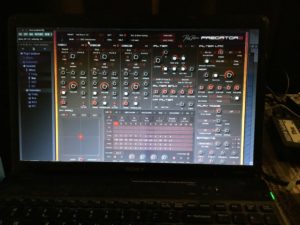Rob Papen Predator has been a leading software synthesizer for years, known for its excellent virtual analog sound and an intuitive user interface. Needless to say, the recent release of its successor was highly anticipated throughout the synth plugin world. Predator 2 does not disappoint, with a host of new features to go along with that timeless Rob Papen sound.
Rob Papen Predator 2 Features
- Three Dual Oscillators – in Stereo
- 128 Waveforms – Including Eight User-Defined
- Three Filters – also in Stereo (Two Multimode, One High-Pass)
- Four Envelopes and LFOs with Modulation Matrix
- X-Y Pad for Control Modulation
- Dual 16-step Arpeggiators
- Three-Band EQ
- Three Independent Virtual Effects Units
- Nearly 6000 Presets
- Supports Most Popular Plugin Formats
- Street Price of $149 — $49 Upgrade from Predator
A supercharged update of the original, Rob Papen Predator 2 offers enough to attract both new users and current Predator owners looking to upgrade. Let’s dive into the details.
An Intuitive Virtual Synth Interface
Predator 2 fits the entire interface on one screen, with a separate multi-page section in the middle to manage the arpeggiators, modulation matrix, LFOs/envelopes and more. In that regard, the UI design is similar to that of SynthMaster One. Predator 2 also offers an Easy Mode – a streamlined view displaying only the most important controls.

A separate browser and management page serves as a librarian for user and preset patches – there are nearly 6000 of the latter! This synth layout should feel comfortable to anyone familiar with subtractive synthesis. While some might complain about Predator 2’s dark color scheme, it works for me.
Powerful Oscillations Abound
Like many other virtual synths, Predator 2’s oscillator section is very powerful, featuring three dual oscillators in stereo. You are able to choose between 128 different waveforms for each oscillator, including eight user-defined waveforms. Of course, combining each oscillator’s two waveforms in a myriad of ways is possible; going beyond mere oscillator sync.
In short, when combined with the user waveform feature, the sonic possibilities of Predator 2 are essentially limitless. Expect to spend some time exploring the thousands of presets to get a feel for its depth.
Filter Flexibility
Predator 2 sports two multimode filters, with a third high-pass filter adding a measure of flexibility. For the multimode filters, expect the standard array of options: low-pass, high-pass, band-pass, notch, as well as more esoteric modes, like formant, comb, vox, and ring. You are able to run the two filters in series or in parallel.
A pre-filter distortion circuit adds a measure of grit or bite to the proceedings. The filter section also includes its own envelope and LFO.
Other Predator 2 Features
Predator 2’s amp section handles the synth’s volume and panning, with its own dedicated envelope as well. You are also able to control the volume based on the note velocity. A distortion circuit and an EQ preset setting round out the amp’s functionality.
Play Mode lets you switch between arpeggiator, polyphonic, monophonic or legato styles. This section also includes portamento settings in addition to a one-finger chord mode and a strum mode usable when playing chords – obviously useful for guitar patches.
The synth boasts two separate 16-step arpeggiators which can be joined together to create a 32-step option. Thankfully, odd time signatures are supported. This arpeggiator is flexible and easy to use.
As noted earlier, management of the arp is handled in the Multi-page section at the center of the interface; you can also access settings pages for the modulation matrix, X-Y pad, user-defined waveforms, the three different effects, and chord mode. It is a useful interface feature, allowing access to the Predator 2 architecture from one master page.
Speaking of the X-Y pad – it is one of Predator 2’s coolest features. You are able to record, play, and loop movements on the pad, allowing for robust real-time modulation of synth parameters. Even visually attractive and musically useful spiral patterns are possible.
A Must-Have Software Synthesizer
Given the legendary status the original Predator holds among software synthesizers, the anticipation for its sequel was naturally quite high. Rob Papen Predator 2 succeeds at upholding that legacy. It provides power, flexibility, an interesting feature set, and most importantly – great sound.
If you are looking to either upgrade a copy of the original or embark on your first exploration of the Rob Papen sonic universe, Predator 2 definitely belongs in your synth plugin library. I’ve already used its warm sound on an upcoming Church of Hed project.




Pingback: Aftertouch adds 3D Touch Control to your iOS Synths – Synth News Digest 9 | TabMuse -- a Home for Digital and Analog Music Inspiration
Pingback: Hitting the Deep End with Rob Papen SubBoomBass 2 | TabMuse -- a Home for Digital and Analog Music Inspiration